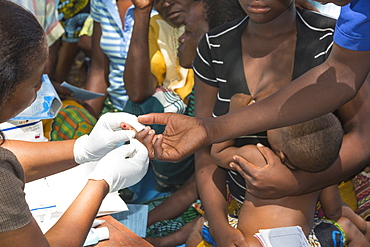Recent searches
Loading...
1350-6678 - Strawberry Poison Frog (Dendrobates pumilio), adult, Bastimentos National Park, Bocas del Toro, Panama. The strawberry poison frog or strawberry poison-dart frog (Oophaga pumilio or Dendrobates pumilio) is a species of small amphibian poison dart frog found in Central America. It is common throughout its range, which extends from eastern central Nicaragua through Costa Rica and northwestern Panama. The species is often found in humid lowlands and premontane forest, but large populations are also found in disturbed areas such as plantations. The strawberry poison frog is perhaps most famous for its widespread variation in coloration, comprising approximately 15���30 color morphs, most of which are presumed to be true-breeding. O. pumilio, while not the most poisonous of the dendrobatids, is the most toxic member of its genus. The species is most diverse in Panama with varieties in vivid shades of all red, orange, blue, yellow or green, green and yellow, white with red, orange or black and spotted varieties. The most colorful mix is found in Isla Bastimentos Marine National Park though not all in one place. Colors vary by location. A beach on the north side of the island is named after the species. Two of Southern Explorations' Panama tours visit red frog habitat. Both the eight-day Panama Adventure trip and eleven-day Panama Highlights trip spend time in Isla Bastimentos Marine National Park and the former also goes to Red Frog Beach.
The red frog is not as poisonous as some of its cousins and is not a threat to humans. It subsists on a diet of ants that dine on poisonous plants, providing the red frog its protective skin toxin. Males attract females with a loud quick chirp. To hear the distinctive sound before you depart on your Panama tours, go to the University of Michigan Museum's biodiversity website (www.animaldiversity.ummz.umich.edu.) After birth, the tadpoles climb aboard the mother who deposits them in different protected areas where she retu
1178-41579 - Arm of Caucasian woman holding bouquet of roses
1178-41978 - String tied around package wrapped in brown paper
1178-39045 - Hands of Caucasian woman wrapping Christmas gifts
1178-39044 - Hands of Caucasian woman holding Christmas gifts
1178-39020 - Hand of woman offering red apple to man
1178-38656 - Hands of woman holding round gift box
1178-38658 - Hands of woman cupping valentine gift box
1178-37634 - Older man proposing marriage to woman in restaurant
1350-4016 - A pulling unit or workover rig providing maintenance on an oil well in the canyon country of Utah.
1116-52119 - Travelers inside a camper van looking over a map for directions while exploring the cliffs surrounding Dubrovnik providing stunning views of the coastal city; Dubrovnik, Dubrovnik-Neretva County (Dubrovačko-neretvanska županija), Croatia
1178-33672 - Caucasian girl hiding gift for grandmother behind back
1178-32933 - Close up of woman leaning on wrapped gift
1178-34488 - Businesswoman giving presentation in office meeting
1178-33671 - Caucasian girl giving grandmother a gift in living room
1178-33274 - Husband serving coffee to wife in bubble bath
1178-33666 - Caucasian woman giving student piano lessons
1178-33667 - Caucasian woman giving student violin lessons
1178-32765 - Hispanic mother giving daughter piggyback ride
1178-32535 - African woman handing credit card over bar
1350-96 - The partial eclipse of the Sun, October 23, 2014, as seen from Jasper, Alberta, in this case shot through thin cloud but that makes for a more interesting photo than one in a clear sky. This is still shot through a mylar filter, on the front of a 66mm f/6 apo refractor using the Canon 60Da for 1/25 sec exposure at ISO 100. The colours are natural, with the mylar filter providing a neutral 'white light' image. With the Sun dimmed a lot by cloud, the longer exposure allowed picking up light and colours in the surrounding clouds.
1350-97 - The partial eclipse of the Sun, October 23, 2014, as seen from Jasper, Alberta, shot under clear skies through a mylar filter, on the front of a 66mm f/6 apo refractor using the Canon 60Da for 1/8000 (!) sec exposure at ISO 100. The colours are natural, with the mylar filter providing a neutral 'white light' image. The big sunspot on the Sun that day is just disappearing behind the Moon's limb. The mylar filter gave a white Sun, its natural colour, but I have tinted the Sun's disk yellow for a more pleasing view that is not just white Sun/black sky.
1219-41 - Palm trees providing shade along a deserted sandy beach in the Seychelles, Indian Ocean, Africa
1211-45 - Primary school of the Leparua people, providing education as well as medication, Kenya, East Africa, Africa
911-10939 - In mid January 2015, a three day period of excessive rain brought unprecedented floods to the small poor African country of Malawi. It displaced nearly quarter of a million people, devastated 64,000 hectares of land, and killed several hundred people. This shot shows A Medicin Sans Frontieres clinic in Makhanga testing local people for malaria, many of whom proved positive for the disease, as a result of the drying up flood waters providing ideal breeding grounds for mosquitoes.
911-10940 - January 2015 saw a three day period of excessive rain which brought unprecedented floods to the small poor African country of Malawi. It displaced nearly quarter of a million people, devastated 64,000 hectares of land, and killed several hundred people. This shot shows A Medicin Sans Frontieres clinic in Makhanga testing local people, many of whom now have malaria, as a result of the drying up flood waters providing ideal breeding grounds for mosquitoes.
911-10941 - January 2015 saw a three day period of excessive rain which brought unprecedented floods to the small poor African country of Malawi. It displaced nearly quarter of a million people, devastated 64,000 hectares of land, and killed several hundred people. This shot shows A Medicin Sans Frontieres clinic in Makhanga providing Malaria treatment drugs to local people, many of whom now have malaria, as a result of the drying up flood waters providing ideal breeding grounds for mosquitoes.
1178-21796 - Man giving girlfriend piggy back ride, Utah, United States
1178-21753 - Senior man giving wife piggy back ride, Utah, United States
1178-2838 - Close up studio shot of woman's hand holding money
1178-2840 - Close up studio shot of woman's hand holding Mexican money
1178-2839 - Close up studio shot of woman's hand and money
1178-2741 - Portrait of couple holding Christmas gift
1178-2837 - Close up studio shot of woman's hand holding money
1178-2235 - Woman stuffing gifts into Christmas stocking
911-10139 - Solar panels on the Cabanne D' Orny in the Swiss Alps, providing electricty for this off grid mountain hut at over 10,000 feet.
832-338357 - EnBW power and incineration plant in Stuttgart-Muenster, Stuttgart, Baden-Wuerttemberg, Germany
1161-1780 - A clown laughing during a community picnic where local groups are providing musical and dance entertainment to celebrate the ethnic diversity of West London at Gunnersbury Park
1161-627 - White-fronted tern (Sterna Striata) in flight with fish in beak, across the Hauraki Gulf off the Coromandel Peninsula, North Island, New Zealand
911-9802 - A combined heat and power plant providing hot water for space heating in Almere, Netherlands, Europe
911-8926 - Solar photo voltaic panels and solar thermal panels providing electricity and hot water for a farm house on Bodmin Moor, Cornwall, England, United Kingdom, Europe
911-8927 - Solar photo voltaic panels and solar thermal panels providing electricity and hot water for a 16th century farm house on Bodmin Moor, Cornwall, England, United Kingdom, Europe
911-6086 - A lady who was horribly burned in a house fire and who now work for the Peter Hughes Burn Foundation providing counselling and support for the victims of bush fires, Australia, Pacific
911-6085 - Grazi Lisciotto who was horribly burned in a house fire and who now work for the Peter Hughes Burn Foundation providing counselling and support for the victims of bush fires, Australia, Pacific
733-3023 - A Bai girl carrying buckets of water in front of a water wheel in Lijiang Old Town, UNESCO World Heritage Site, Yunnan Province, China, Asia
641-9639 - Buddhist monks collecting alms in the early morning, Luang Prabang, Laos, Indochina, Southeast Asia, Asia
367-5508 - Facade of St. Paul's Cathedral, Macau, China, Asia
700-6144 - Italy, Rome, Santa Maria Maggiore Basilica, Devices For Providing Multilingual Explanations
255-8799 - The Elan Valley, site of reservoirs providing water for Birmingham, Powys, Wales, United Kingdom, Europe
255-8800 - The Elan Valley, site of reservoirs providing water for Birmingham, Powys, Wales, United Kingdom, Europe
255-8801 - The Elan Valley, site of reservoirs providing water for Birmingham, Powys, Wales, United Kingdom, Europe
255-8802 - The Elan Valley, site of reservoirs providing water for Birmingham, Powys, Wales, United Kingdom, Europe
450-3929 - Novice Buddhist monks collecting alms of rice, Luang Prabang, Laos, Indochina, Southeast Asia, Asia
252-9978 - Novice monk receiving alms in the early morning, Luang Prabang, Laos, Indochina, Asia
You reached the end of search results









































































